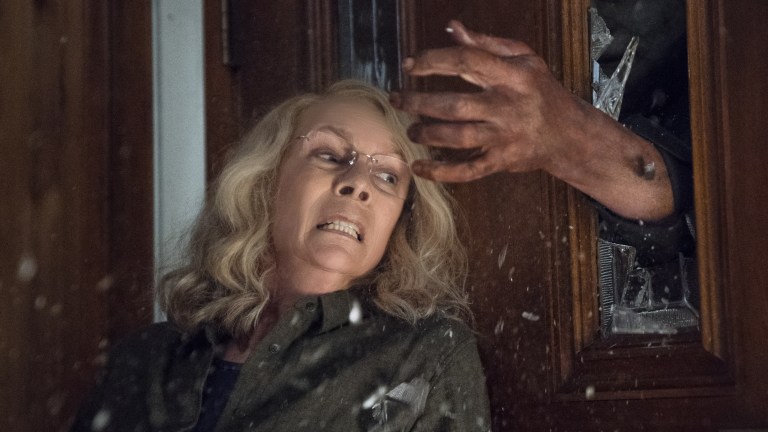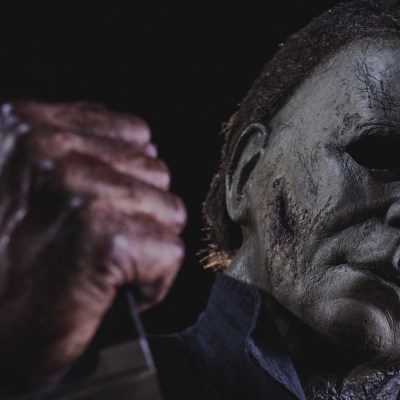Halloween: Why the Blumhouse Timeline Beats All Other Continuities
The Halloween franchise has more timelines than Back to the Future, but the current Blumhouse one is still the best.

This article contains Halloween Kills spoilers.
What compels Michael Myers? Why does he wear the mask? What once seemed to be a simple but ominous question to psychiatrist Samuel Loomis—because he’s EVVILLL!—has somehow led to a dizzying variety of answers among the Halloween franchise’s various timelines and narrative cul-de-sacs.
Michael could be evil because of a traumatic childhood and personality disorders, as per Rob Zombie’s recent remakes, or he could be evil because he is the reflective embodiment of an entire town’s hypocrisy (see: Halloween Kills). Heck, in what is arguably the original timeline (more on that later), it’s revealed that Michael Myers has actually been a victim possessed by the curse of an evil Druid cult! (Halloween: The Curse of Michael Myers is a special kind of awful.)
There are seemingly a dozen different explanations, and nearly a dozen different Halloween timelines. We’ve already unpacked the most confusing tangents right here, but if you don’t want to spend your time turning a slasher movie into a graduate studies course, we can also just tell you flat-out which is the best Halloween timeline to follow: the current one divided between John Carpenter and David Gordon Green, and starring Jamie Lee Curtis.
Admittedly this is a faintly controversial choice in light of our own reviewer disliking Halloween Kills (along with most critics), but despite that newest installment’s many, many warts, when all things are considered, the Blumhouse-produced timeline that currently consists of Halloween (1978), Halloween (2018), and Halloween Kills (2021) is the most effective expansion on Carpenter’s original film about the empty void we call “The Shape.”
Michael Myers Is Scarier Without a Motive
One of the most interesting reactions among both longtime fans and critics toward Halloween Kills is that it reminds us of an often forgotten fact: Going after Laurie Strode was never meant to be personal for Michael Myers. This simple idea was also present in 2018’s Halloween, but it was easier to overlook when Curtis’ heroine was so righteously infuriated with getting back at her stalker/boogeyman 40 years later. Halloween Kills makes their lack of connection crystal clear, however. The night Michael followed Laurie home was the worst day of her life. But for Michael… who knows? It was probably just another seasonal Oct. 31 party.
This fact has been muddied for decades by an idea that Michael Myers creators John Carpenter and Debra Hill admittedly introduced themselves in their story treatment for the original sequel to their 1978 masterpiece, Halloween II (1981). In that original continuation of the story (which Carpenter later came to regret), the film revealed that Laurie was actually Michael Myers’ long lost sister, a young woman who was adopted by the Strode household after the gruesomeness committed by her big brother Mikey when she was just a baby. It’s a fairly absurd twist, but it turned out to be savvy for a long-running series where Michael Myers—unlike, say, Jason Voorhees—had an actual motivation. As it turns out, he was hunting down every living member of his family!
Technically, Halloween II ended pretty definitively on its own, giving final resolution to the first film as Laurie and Dr. Loomis (Donald Pleasence) killed the boogeyman seemingly for good (which makes the original first two films their own mini-timeline if you want to see it that way). However, when producer Moustapha Akkad decided he wanted more Michael, continuing that timeline after Curtis decided not to come back became a mere formality of just revealing further and further tenuously distant relations. First there was Laurie’s daughter, the adorable and tragic Jamie Lloyd (Danielle Harris), and then there was more incredulously teenage Jamie Lloyd’s baby boy, which made Michael the great-uncle from Hell by the ‘90s.
It all starts to become a bit tired. And the more filmmakers tried to explain that cruel motivation, the worse the movies became, hence the aforementioned evil cults and pursued babies in The Curse of Michael Myers (1995), plus Zombie’s own deconstructionist remakes which were all about Michael’s obsession with family.
The beauty of Halloween (2018) is it returns to the simplicity of the original movie in a way that even the similarly conceived Halloween: H20 (1998) failed to do. That 20-year anniversary film was the first outright attempt to reboot the series, with Curtis returning as a traumatized little sister, and Jamie Lloyd being erased from continuity. But it was still about Laurie and her wacky big brother. It works… but when you go back and watch the 1978 classic in a vacuum, that movie works even better.
That’s because in Carpenter and Hill’s original script, Michael decides to follow Laurie Strode for no discernible reason. He’s just standing at the window where he murdered his older sister for equally incomprehensible reasons 15 years earlier, and then he sees her: another young woman who happens to have popped up in his line of sight. The hunt is on. There’s no logic, no rationalization. He’s just freaking evil.
By erasing even the likable Halloween II, Green’s Halloween (2018) comes the closest to recapturing the thesis of Carpenter’s defining slasher film: evil can exist in any town and in any home, and its motives are incidental. It just is, man. And in the newest timeline, an elderly Laurie Strode has known that for four decades, and harped on it until even her own daughter (an always underrated Judy Greer) ceased to believe her. Folks don’t want to hear how fragile their lives are, and how susceptible they are to corruption.
Laurie’s known, and when evil came home again, she’s ready—even if it wasn’t looking for her this time.
Haddonfield Feels Like a Real Town
That’s because one of the other very savvy choices made by Green and his co-writer Danny McBride is to open up Haddonfield in a way no other sequel has. If you return to the original premise that Michael is a manifestation of evil incarnate, who strikes at random, then you shouldn’t limit his killing spree to direct relations. If he’s still out there, that means there’s room to open up the whole Haddonfield chessboard.
Of course Halloween Kills is a muddled, underdeveloped movie which lacks the cohesiveness or grace to fully realize its setup about a whole town being corrupted by the legacy of a monster like Michael Myers living in their midst. Nevertheless, unlike any other slasher movie I can think of barring the first several Scream movies, Green and McBride’s Haddonfield feels like a real community that has to grapple with this horrible series of events. That begins in the first film where we witness Michael’s legacy first being addressed by the ill-fated podcasters who have the audacity to try and interview the Shape, but it continues as we see Michael cut a bloody path at random as he wanders into any unlocked door he can find.
In spite of its faults, one of the most interesting things about Halloween Kills is it expands how survivors from the 1978 and 2018 films react to the very night these killings occur. In the case of ’78, we have new and surprisingly effective scenes filmed in Carpenter’s style set on that fateful night, only we are witnessing the mind-numbing horror from the vantage of the local sheriff’s department instead of Laurie Strode. This includes the sheriff whose daughter was killed in the original film (an element which it should be noted Rob Zombie first actually explored in one of the better aspects of his remakes with the casting of Brad Dourif as the sheriff).
We then see how those same officers, retired or close to it, deal with Michael’s return in 2018. They’re then contrasted with the survivors of the most recent attacks, including Laurie as well as Laurie’s middle-aged daughter, Karen, who is more of a protagonist in this film than Laurie. Even little Tommy Doyle from the ‘78 movie has grown up into a bitter MAGA type played by Anthony Michael Hall. When these characters’ experiences are combined, they create a portrait of evil that’s bigger than Laurie’s pain. It is of a community that is festering due to the touch of Michael’s knife, and which feels chillingly prescient when you realize that Green and company wrote and shot their little horror movie about an American town descending into chaos and mob rule before the pandemic, before the Jan. 6 insurrection attempt, and before the further fraying of our own society.
Say what you will about the quality of the film, but Halloween Kills introduces new ideas that make Michael Myers’ legacy seem fuller, and therefore scarier.
Jamie Lee Curtis Is Still the Heart of Halloween
With that said, even if Laurie no longer matters to Michael in the new timeline, he still matters to her. Hence Laurie will hopefully have her true vengeance in the next movie, because if we’re being honest, the main reason 2018’s Halloween reboot worked so well is because of Curtis’ ferocious return.
The character made Curtis a star, and she revisited it several times since then, but the 2018 movie really put all of the grief and trauma Laurie must be feeling on Curtis’ shoulders, and she played the role with the aggression of an unstoppable force of nature in her own right. For the first time, Michael Myers had a counterpoint as mythic as The Shape.
Of course Donald Pleasence filled a similar function in Halloween II, as well as the more dubious Halloween 4 through Halloween 6. But as wonderful as Pleasence is, his slasher movie Van Helsing could never be the one to stick the proverbial stake through the heart. In the original Dracula novel (and its better film adaptations), it was always the people that the monster personally wronged who end the nightmare. And Halloween has never seen a more compelling protagonist than Jamie Lee Curtis as Laurie Strode.
So while Halloween Kills broadened the scope, for Halloween Ends to stick the landing, it’ll need Laurie to step back into the center of the frame. This is her story, even if the beef is one-sided. This is only more necessary after the shock (and frankly stupid) twist ending of Halloween Kills where Michael somehow kills Karen without anyone else on the street or in the house knowing he’s returned.
Nonetheless, Laurie needs her final vindication, and Curtis needs to devour the screen again. Let them fight! Otherwise….
There Is Still Always the Original
You could always just consider the 1978 movie as its own standalone “timeline.” I tend to do that when I watch it every few Octobers. The 2018 film was the first time the series actually returned to the source of the dread in that classic, creating a new timeline finally worthy of Carpenter and Hill’s original premise. If Halloween Ends stumbles worse than this year’s Peacock release, there’s no reason to not go back to treating the classic as how it was always intended: a standalone glimpse into the pitiless eyes of evil.

